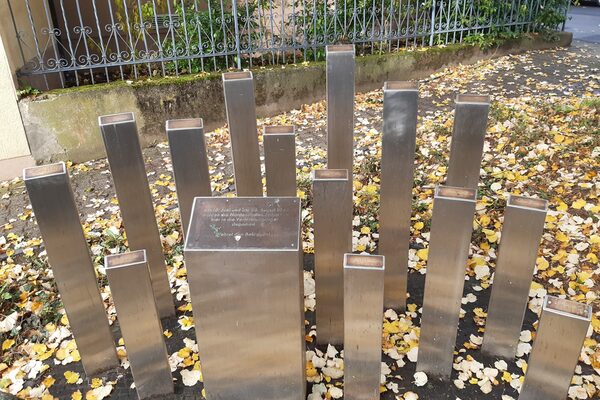Memorial to the Jews of Nordenstadt
On December 7, 1994, the memorial designed by Marc van de Broek in Nordenstadt, Stolberger Straße/corner of Heerstraße, in front of the old town hall was handed over to the citizens.
Escalation of violence against Jews in the Third Reich
The key ideological conviction of National Socialism was anti-Semitism. The persecution of Jews and their exclusion by the German majority society therefore began as soon as Adolf Hitler came to power on January 30, 1933. Over the course of the National Socialist dictatorship, they took on ever more severe forms until the escalation of violence during the November pogroms of 1938. They are regarded as the prelude to the genocide of the European Jews, the Shoah.
On the night of November 9-10, 1938, marauding SA troops set fire to synagogues throughout the German Reich. The fire departments usually only intervened when neighboring buildings were threatened by fire. The pretext for the organized arson attacks was provided by the shooting of the Legation Secretary of the German Embassy in Paris, Ernst vom Rath, by 17-year-old Herschel Grünspan. Immediately after the November pogroms, numerous measures were introduced against the Jewish population. For example, insurance payments for damage suffered during the pogroms were confiscated. They were banned from attending theaters and other cultural events. Jewish doctors and lawyers were banned from practicing. Savings were confiscated and a special collective tax of one billion Reichsmark was imposed on Jews. Jewish children were excluded from public schools. In Wiesbaden, a barrack was built for them on the grounds of Mainzer Straße 10. From 1941, all Jews who had reached the age of six had to wear a "Jewish star".
At the "Wannsee Conference" on 20 January 1942, 15 high-ranking officials, including Reinhard Heydrich and Adolf Eichmann, met in a villa on the eponymous Wannsee in Berlin to coordinate the organization and logistics of the mass murder of European Jews. The extermination camps Auschwitz, Belzec, Chelmno, Majdanek, Sobibor and Treblinka were set up in occupied Poland. The Jewish population was deported to the extermination camps from all over the German Reich and from the territories occupied by German troops. The SS, police and Wehrmacht worked hand in hand. The number of people who fell victim to this genocide is estimated at six million.
The deportation of the Jews from Nordenstadt
The number of Jews in Nordenstadt had been steadily declining since 1933. Some managed to flee abroad, others moved to family and friends in other German cities in search of safety. In July 1941, there were still 16 Jews living in Nordenstadt. On June 10, 1942, twelve of them, including one-year-old Paul Frank, were taken to the town hall and deported from there, together with Jews from other communities in the Main-Taunus district, to the German-occupied eastern territories. Two older people who stayed behind were taken to the Theresienstadt camp in a second deportation train.
Establishment of the memorial in Nordenstadt
On December 7, 1994, a memorial was opened to the public in memory of the murdered Jews of Nordenstadt. The memorial is located on a small green area on the corner of Heerstraße and Stolberger Straße, directly in front of the former town hall, the starting point of the deportation of the Nordenstadt Jews. The Belgian-born Wiesbaden artist Marc van den Broek designed and erected the memorial. It consists of 14 metal steles. A brass plaque is attached to the top of each one, bearing the names of the murdered Nordenstadt Jews.
The memorial is dedicated to: Erna Wolf, Else Weis, Elise Weis, Leo Ochs, Frieda Ochs, Sylvia Ochs, Benny Schönfeld, Clementine Schönfeld, Sali Löwenstein, Frieda Löwenstein, Irena Frank, Ludwig Frank, Paul Frank, Josef Joseph.
On another stele, also on a brass plate, is the explanation:
On June 10 and August 28, 1942, the Nordenstadt Jews were deported from here to the extermination camps. Resist the beginnings!
Further information
City archive
Address
65197 Wiesbaden
Postal address
65029 Wiesbaden
Arrival
Notes on public transport
Public transportation: Bus stop Kleinfeldchen/Stadtarchiv, bus lines 4, 17, 23, 24 and 27 and bus stop Künstlerviertel/Stadtarchiv, bus line 18.
Telephone
- +49 611 313022
- +49 611 313977
Opening hours
Opening hours of the reading room:
- Monday: 9 a.m. to 12 p.m.
- Tuesday: 9 am to 4 pm
- Wednesday: 9 am to 6 pm
- Thursday: 12 to 16 o'clock
- Friday: closed
